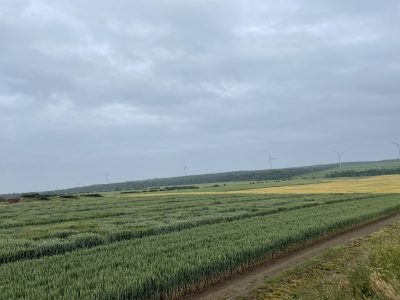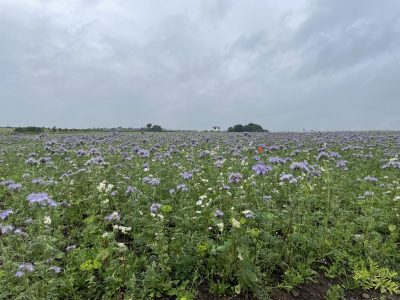It may have been pretty wet, but it didn’t dampen the conversation and debate at our Open Day this week. Variety choice was a hot topic as Scottish Agronomy members descended on Scotland’s largest crop trials site at Balgonie in Fife to make decisions on the best return on investment for the new growing year. During the various tours of the trials, which also welcomed distillers, breeders and seed merchants, discussion also centred on reducing carbon, the surge in Septoria and cover cropping for different gains.
There are 13,500 trials plots at Balgonie, one of our farmer co-operative’s 12 geographically spread trials sites, testing different varieties and treatments across crops including wheat, barley, oats, oilseeds, linseed, rye, triticale and cover crops. In a new format this year, growers focused on crops relevant to them rather than a full site tour, as well as the opportunity to see the farm-scale impact of cover cropping for a pan-European partridge project in conjunction with GWCT that is also feeding positively into marketing contracts.

Managing Director of Scottish Agronomy, Adam Christie, said:
“Growing is becoming more complex as we are challenged with how chemistry deals with disease and this makes variety choice in particular very important, but we’re also looking at the science behind cover cropping and integrating other measures. The advantage of coming out on site is to see in a live situation how different crops are reacting to different treatments and make decisions that will suit your farming enterprise. There’s no one size fits all solution, some growers will take a chance with a dirtier variety choice, others on the level of inputs, but what we do is give members the evidence and the tools to make key decisions and find the sweet spot for their own business.”
 With Septoria proving a particular issue this season in some soft wheat varieties, Scottish Agronomy’s Deputy Managing Director and Head of Combinable Crops, Greg Dawson, said that there is opportunity to bring hard wheats into distilling – which would also aid the supply chain’s drive to reduce its carbon footprint:
With Septoria proving a particular issue this season in some soft wheat varieties, Scottish Agronomy’s Deputy Managing Director and Head of Combinable Crops, Greg Dawson, said that there is opportunity to bring hard wheats into distilling – which would also aid the supply chain’s drive to reduce its carbon footprint:
“Protocol has dictated that only soft wheats are tested for their distilling value in the Recommended List, but a piece of work we did last year showed that for one particular hard wheat variety, when you multiply its field yield in tonnes per hectare by its spirit yield in litres per kilogram of grain, it was 10% better than a soft wheat which is taking the dominant share of the market. That has a real knock-on effect for the carbon footprint of the product which is coming out of any particular distillery.”
Mr Dawson also warned against the headline figure of simply cutting back nitrogen to reduce carbon footprint:
“You could be reducing the yield per hectare if you underfeed it, and therefore need to grow more hectares to meet demand, so the simple message of cutting nitrogen at the producer end to cut carbon footprint is flawed. At Scottish Agronomy, we are putting down specific work to replicate what the consequences are of different decisions so the whole supply chain can decide how to best decarbonise the industry and run profitable businesses.”
 At Scottish Agronomy, we have introduced rotational cover crop trials this year with different options to examine the effects on follow on cash crops, to give science-based evidence for what growers want to achieve – be it biofumigation to mitigate PCN; soil structure improvements; or retention of fertility within the rotation which would otherwise be lost. Scottish Agronomy is also offering members a four-part course on Connecting Healthy Soils this Autumn.
At Scottish Agronomy, we have introduced rotational cover crop trials this year with different options to examine the effects on follow on cash crops, to give science-based evidence for what growers want to achieve – be it biofumigation to mitigate PCN; soil structure improvements; or retention of fertility within the rotation which would otherwise be lost. Scottish Agronomy is also offering members a four-part course on Connecting Healthy Soils this Autumn.
“The most sustainable option for the future of agriculture in Scotland is likely to be a middle ground between variety, inputs and a regenerative approach,” says Mr Christie.